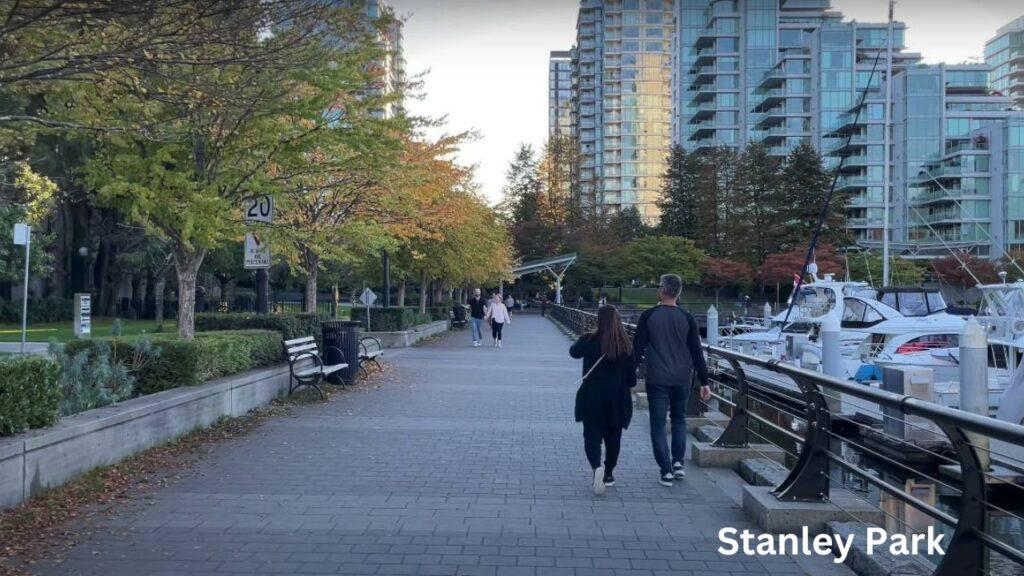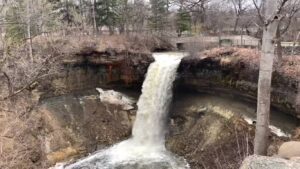Stanley Park is one of the most iconic and beloved places in Vancouver, Canada. It is a 405-hectare (1,001-acre) urban park that sits on a peninsula surrounded by the Pacific Ocean. It was established in 1888 and named after Lord Stanley, the sixth Governor General of Canada. Stanley Park is a natural oasis that offers a variety of attractions and activities for visitors of all ages and interests. Whether you want to enjoy the stunning views, explore the rich history and culture, or have some fun and adventure, Stanley Park has something for you. We will guide you through some Nearby Locations in Stanley Park and help you plan your visit to this amazing destination.
Nearby Locations in Stanley Park
The Seawall: Stanley Park
The seawall is a 28-kilometer (17-mile) paved path that circles the park and the downtown waterfront. It offers spectacular views of the ocean, mountains, city skyline, and various landmarks, such as Lions Gate Bridge, Siwash Rock, and Brockton Point Lighthouse.
The seawall is divided into two lanes: one for pedestrians and one for cyclists and skaters. You can start from any point along the seawall and go either clockwise or counterclockwise. The entire loop around Stanley Park takes about two to three hours to complete, depending on your pace and stops.
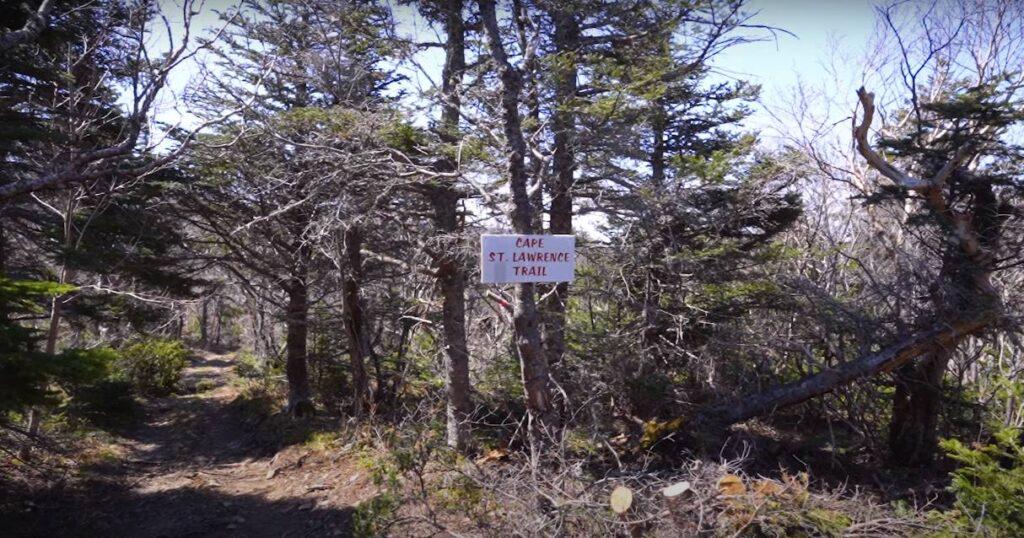
You can also choose to do a shorter section of the seawall, such as the 9-kilometer (5.6-mile) stretch from Coal Harbour to English Bay. If you don’t have your bike or skates, you can rent them from one of the many shops near the park entrance.
Some tips and recommendations for making the most of the seawall experience are:
- Bring water, sunscreen, and a hat, and dress comfortably and suitably for the walk.
- Follow the signs and respect the rules of the road. Stay on your designated lane and keep to the right. Pass others on the left and signal your intentions.
- Be aware of your surroundings and watch out for wildlife, such as raccoons, squirrels, geese, ducks, herons, eagles, and seals.
- Stop at the various viewpoints and attractions along the way, such as the Totem Poles, Prospect Point, Third Beach, Second Beach Pool, Lost Lagoon, etc.
The Vancouver Aquarium: Stanley Park
Another must-see attraction in Stanley Park is the Vancouver Aquarium. It is Canada’s largest aquarium and one of the most respected marine research centers in the world.
The Vancouver Aquarium houses over 50,000 animals from over 700 species, including fish, mammals, reptiles, amphibians, birds, and invertebrates. It also features various exhibits and shows that showcase the diversity and beauty of life in the oceans, rivers, lakes, and forests.
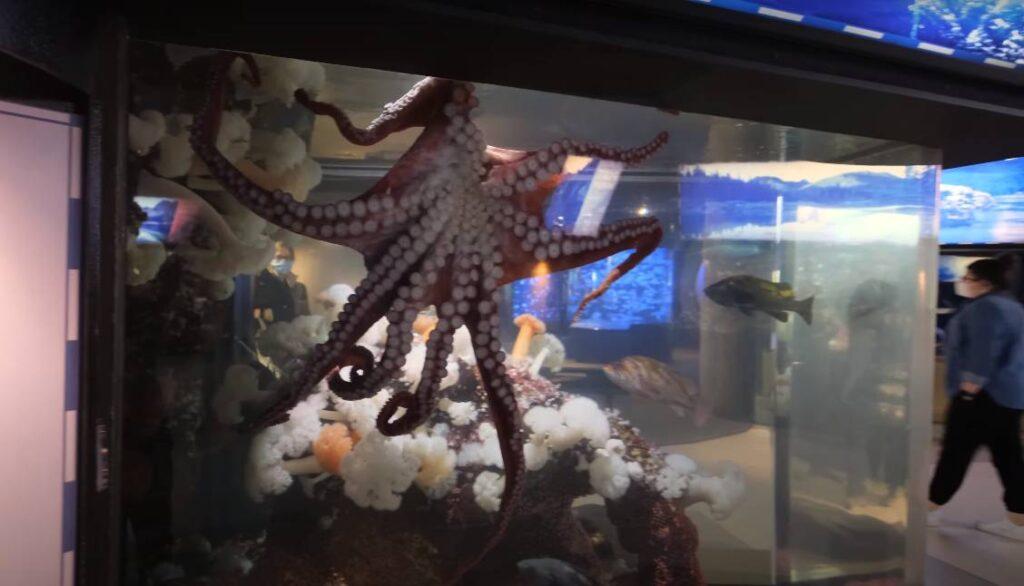
Some of the most popular and unique animals that you can see at the aquarium are:
- The sea otters: These adorable creatures are always a crowd-pleaser with their playful antics and cute expressions. You can watch them swim, dive, groom, eat, sleep, and interact with each other at their habitat near the entrance.
- The dolphins: These intelligent and charismatic animals are known for their acrobatic skills and social behavior. You can see them perform amazing tricks and communicate with their trainers at their habitat near the Wild Coast exhibit.
- The belugas: These white whales are one of the most iconic animals of the Arctic. You can see them glide gracefully through the water and make vocal sounds at their habitat near Canada’s Arctic exhibit.
- The sea lions: These noisy and lively animals are native to British Columbia’s coast. You can see them bask in the sun or splash in the water at their habitat near the Steller’s Bay exhibit.
The aquarium is open daily from 10 a.m. to 5 p.m., except on some holidays. The admission fee is $40 for adults, $30 for seniors (65+), $30 for students (with ID), $23 for youth (13-18), $15 for children (4-12), and free for children (3 and under). You can buy tickets online or at the gate. To get to the aquarium from downtown Vancouver, you can take bus #19 or #240 from West Georgia Street or Burrard Station. Alternatively, you can walk or bike along the seawall or through Stanley Park.
The Beaches: Stanley Park
If you are looking for some relaxation and recreation in Stanley Park, you can head to one of its three main beaches: First Beach (also known as English Bay Beach), Second Beach (also known as Ceperley Beach), or Third Beach (also known as Ferguson Point Beach).
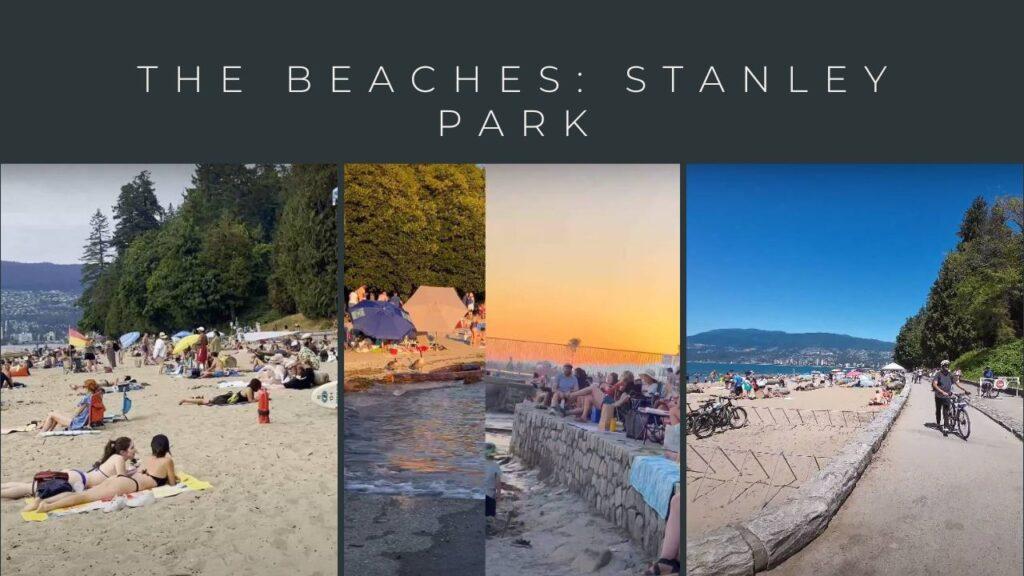
Here is a comparison and contrast of the three beaches:
- First Beach: This is the most popular and crowded beach in Stanley Park. It is located on the south side of the park, facing English Bay. It is also close to many restaurants, shops, and bars on Denman Street and Davie Street. You can enjoy swimming, sunbathing, volleyball, kayaking, paddle boarding, or watching the sunset at this beach. It is also the site of the annual Celebration of Light fireworks festival in July and August.
- Second Beach: This is a family-friendly and quieter beach in Stanley Park. It is located on the west side of the park, near the entrance to the seawall. It has a smaller and pebblier shore, a grassy area with picnic tables and fire pits, a playground, a concession stand, and public washrooms. It also has an outdoor heated pool that is open from May to September. You can enjoy swimming, sunbathing, picnicking, or playing at this beach. It is also close to the Stanley Park Railway and the Vancouver Aquarium.
- Third Beach: This is a secluded and peaceful beach in Stanley Park. It is located on the north side of the park, near Prospect Point. It has a long and sandy shore, a grassy area with picnic tables and fire pits, and public washrooms. It also has a stunning view of the ocean, mountains, and islands. You can enjoy swimming, sunbathing, picnicking, or reading at this beach. It is also a popular spot for drum circles and bonfires in the summer evenings.
Consider the following factors:
- The size and type of your group: If you are with a large group of friends or family, you may prefer First Beach or Second Beach for their space and facilities. If you are with a small group or alone, you may prefer Third Beach for its tranquility and privacy.
- The time and season of your visit: If you are visiting in the morning or afternoon, you may enjoy any of the beaches for their sunshine and warmth. If you are visiting in the evening or at night, you may prefer First Beach or Third Beach for their views and ambiance. If you are visiting in the spring or fall, you may enjoy any of the beaches for their mild weather and fewer crowds. If you are visiting in the summer or winter, you may prefer Second Beach for its pool or First Beach for its fireworks.
- The activities and interests that you have: If you are looking for some fun and adventure, you may prefer First Beach or Second Beach for their water sports and games. If you are looking for some relaxation and meditation, you may prefer Third Beach for its nature and serenity.
The Totem Poles: Stanley Park
One of the most iconic and historic attractions in Stanley Park is the totem poles at Brockton Point. The totem poles are carved wooden poles that represent the stories and symbols of the Indigenous peoples of British Columbia. They can depict animals, humans, supernatural beings, or ancestral crests.
The totem poles at Brockton Point are not original to Stanley Park; they were collected from various locations in British Columbia between 1920 and 1960. They were installed at Brockton Point to commemorate the centennial of British Columbia’s union with Canada in 1971.
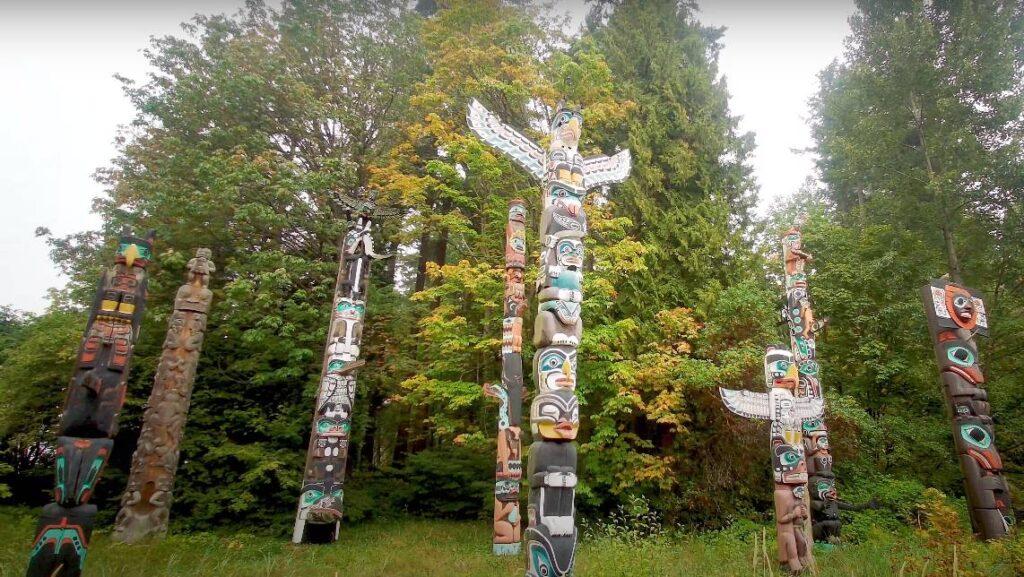
There are currently nine totem poles at Brockton Point; each one has its features and stories behind it.
- The Chief Wakas Pole: This pole was carved by Kwakwaka’wakw artist Henry Hunt in 1962. It depicts Chief Wakas (also known as Chief John), who was a prominent leader of the Kwakwaka’wakw people in the 19th century. He was known for his wealth, power, diplomacy, and generosity. He also adopted many European customs and technologies, such as wearing a top hat and owning a steamship.
- The Thunderbird House Post: This pole was carved by Haida artist Bill Reid in 1988. It depicts a thunderbird on top of a human figure holding a bear cub. The thunderbird is a powerful supernatural being that can create thunder and lightning with its wings. The human figure represents Reid’s grandfather Charles Gladstone (also known as Ninstints), who was a Haida chief from Skidegate.
- The Welcome Figure: This pole was carved by Musqueam artist Susan Point in 2008. It depicts a female figure holding her hands up in a gesture of greeting or blessing. The figure represents Point’s grandmother Edna Grant (also known as Qwiqwelstom), who was a Musqueam elder from Musqueam.
How to Understand the Totem Poles at Brockton Point:
- Read the information panels that explain the origin and significance of each pole. You can also scan the QR codes on the panels to access more details and audio guides on your smartphone.
- Take a guided tour with a cultural interpreter from the Stanley Park Ecology Society. You can learn about the history and culture of the Indigenous peoples of British Columbia, as well as their connection to Stanley Park and its natural environment. The tours are offered daily from June to September, and on weekends from October to May. The tour fee is $15 for adults, $10 for seniors (65+) and students (with ID), $5 for children (6-12), and free for children (5 and under).
- Appreciate the artistry and craftsmanship of the carvers. You can admire the intricate details, vibrant colors, and expressive designs of the poles. You can also notice the differences and similarities among the poles from different nations, such as the Kwakwaka’wakw, Haida, Musqueam, Nisga’a, etc.
- Respect the sacredness and dignity of the poles. You can avoid touching, climbing, or leaning on the poles. You can also refrain from making loud noises or taking disrespectful photos. You can instead show your gratitude and admiration by leaving a small offering, such as a coin, a flower, or a prayer.
Other Attractions: Stanley Park
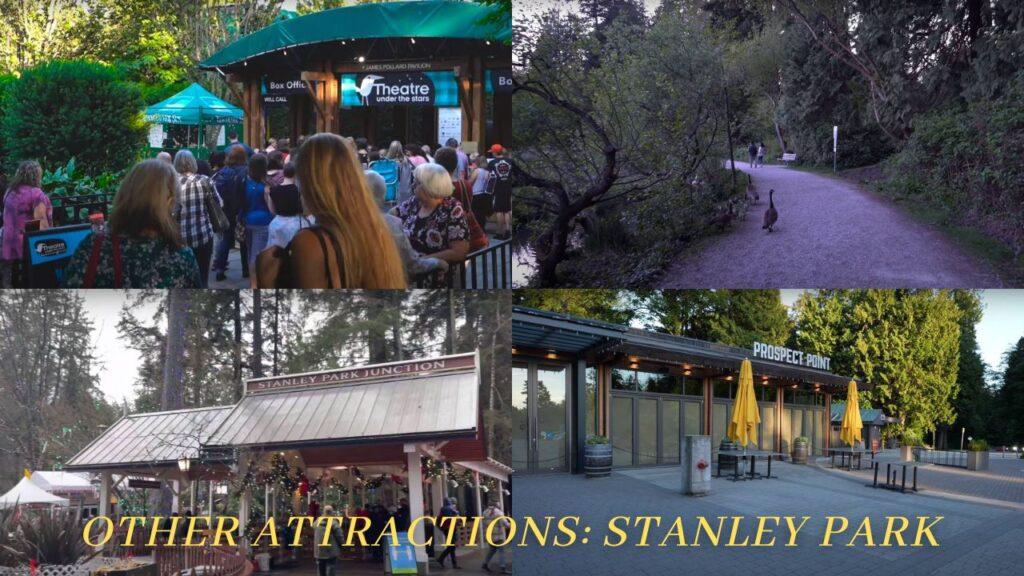
Besides the seawall, the aquarium, the beaches, and the totem poles, many other attractions in Stanley Park are worth visiting.
- Theatre Under the Stars: This is an outdoor musical theatre that performs at Malkin Bowl, a natural amphitheater in Stanley Park. It features two shows every summer, usually one classic and one contemporary. You can enjoy watching talented actors and singers perform under the stars, accompanied by a live orchestra and choreography. You can also bring your picnic or buy snacks and drinks at the concession stand. The shows run from July to August, from Tuesday to Sunday at 8 p.m. The ticket prices vary depending on the front, date, and seat.
- Lost Lagoon: This is a large freshwater lake that was once connected to Coal Harbour. It was named by poet Pauline Johnson, who was inspired by its mysterious and romantic appearance at high tide. It is now home to various wildlife, such as swans, ducks, turtles, raccoons, beavers, etc. You can walk or bike around the lake on a 1.8-kilometer (1.1-mile) trail that offers scenic views and interpretive signs. You can also visit the Lost Lagoon Nature House, a small museum that displays exhibits and information about the lake’s ecology and history.
- Stanley Park Railway: This is a miniature railway that runs on a 2-kilometer (1.2-mile) track through the forest. It offers a fun and nostalgic ride for children and adults alike. You can see various animals and plants along the way, as well as some surprises and special effects. The railway operates from March to October, from 10 a.m. to 5 p.m., except on some holidays. The ticket price is $6 for every one (2 and under ride free). The railway also hosts seasonal events, such as Easter Train, Halloween Ghost Train, and Bright Nights Christmas Train.
- Prospect Point: This is the highest point in Stanley Park that offers panoramic views of Burrard Inlet, Lions Gate Bridge, North Shore Mountains, and West Vancouver. It is also a historic site that marks the location of a naval battle between British and American forces in 1859. You can access Prospect Point by car, bus (#19), bike, or foot. You can also visit the Prospect Point Cafe, a restaurant that serves casual fare and local beers.
Stanley Park is a historic and scenic attraction that offers something for everyone. Whether you want to enjoy nature, culture, or entertainment, you can find it in this urban park. Stanley Park is a must-see destination for anyone visiting Vancouver. To plan your visit to Stanley Park, you can check out its official website, where you can find more information on its attractions, activities, events, maps, directions, etc. You can also download its app, which provides audio tours, interactive maps, photos, videos, etc.
Continue Reading: Travel Destinations in Canada
